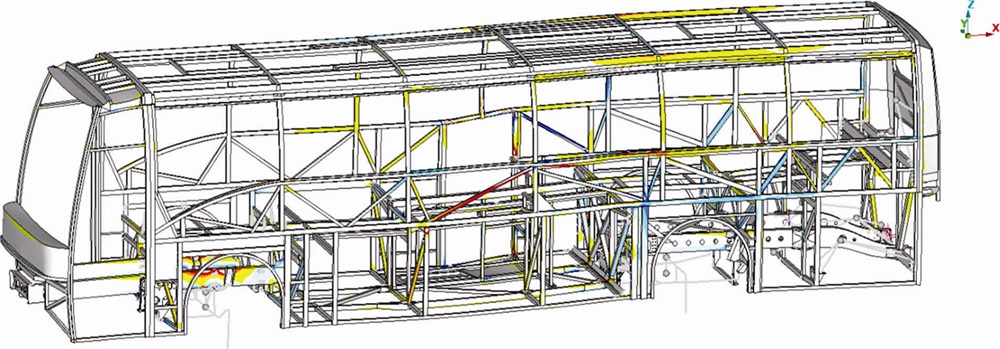Volvo Bus Corporation setzt auf MSC Nastran zur Strukturanalyse
Anders Winkler, Director Solutions Marketing, Hexagon, Manufacturing Intelligence Division

Engineering Reality 2024 Ausgabe 1
Accelerate Smart Manufacturing
Die Simulation spielt beim Design moderner Busse eine wichtige Rolle, um verschiedene Strategien und Szenarien zu modellieren und zu bewerten, bevor ein physischer Prototyp erstellt wird. Ingenieure verwenden Simulationssoftware und -lösungen, um die Leistung eines Fahrzeugs unter verschiedenen Einflüssen zu bewerten, z. B. bei hohen Geschwindigkeiten, im Gelände oder bei ungünstigen Wetterbedingungen. Dies spart Zeit und Geld, da weniger physische Tests sowie Redesigns erforderlich sind.
Die Simulation optimiert die Leistung eines Fahrzeugs, z. B. durch Verbesserung der Kraftstoffeffizienz oder Reduzierung von Emissionen. Die besten Lösungen hierfür werden durch die Modellierung verschiedener Szenarien sowie Tests verschiedener Designoptionen erreicht.
Die Simulation kann in verschiedenen Phasen des Designprozesses eingesetzt werden, von der ersten Konzeptphase bis zur Endprüfung vor der Produktion des Fahrzeugs. Der Einsatz von Simulationen in der ersten Konzeptphase nimmt Einfluß auf übergeordnete Designentscheidungen. Die Simulation in der abschließenden Verifizierungsphase validiert unsere Entwürfe, prognostiziert Probleme, die produktionsseitig auftreten könnten, und kann sogar auf die Notwendigkeit einer höheren CAE-Genauigkeit hinweisen.
Auf die Frage, was die größte Herausforderung beim Einsatz von Simulationen in der Designphase sei, antwortete David: „Einen ausreichend hohen Detailgrad zu finden und zu akzeptieren. Für uns als CAE-Ingenieure wäre es ein Leichtes, jedes noch so kleine Teil mit dem modernsten Solver bis zur feinsten Auflösung zu modellieren.
Bei unseren laufenden Projekten sind wir aber ständig mit einem hohen Zeit- und Kostendruck konfrontiert. Wir müssen bei allem, was wir tun, effizient sein und das heißt, durch Auswahl des optimalen Solvers den jeweils korrekten Detailgrad in unser Modell zu integrieren."

Abbildung 1. SOL 101 Lösungspaket für die Bus-Rohkarosserie.
„Durch den Fokus auf nur einen Solver können wir uns auf die Entwicklung interner Prozesse und Richtlinien für modernere Simulationen zu konzentrieren, die verfügbaren Funktionen in MSC Nastran genau ausloten sowie die Anzahl der über VBC eingesetzten MSC Nastran-Lösungssequenzen erhöhen. Also ja, wir sehen ganz klar die Vorteile dieser Lösung.“
Simulation mit MSC Nastran
MSC Nastran umfasst eine Programmpaket vieler Lösungssequenzen für die Simulation und den Einsatz in unterschiedlichsten Anwendungsbereichen. Die Lösungssequenz SOL 101 wird beispielsweise verwendet, um die statische Steifigkeit von Strukturen zu messen. Im Busdesign wird dabei die Gesamtsteifigkeit der Karosserie geprüft sowie bestimmte Bereiche der Rohkarosseriestruktur visualisiert, die starkem Druck oder Spannung ausgesetzt sein könnten.
Mit SOL 400 lässt sich das hochgradig nichtlineare Verhalten von produktberührenden Komponenten visualisieren, wie z. B. vorgespannte Schrauben.
Das umfassende Paket an Lösungssequenzen in MSC Nastran setzt Volvo Buses als Standard-Solver für Strukturen ein. David fährt fort: „Heute haben wir eine Modellbibliothek, die fast ausschließlich aus Modellen besteht, die für MSC Nastran erstellt wurden. Wir führen Simulationen mit verschiedenen MSC Nastran-Lösungssequenzen durch, die mehrere Merkmale wie Beständigkeit, NVH und Composite unterstützen. Da wir uns auf eine Softwareumgebung konzentrieren, können wir uns genauer mit neuen Funktionen wie CAE Fatigue/NEF beschäftigen und uns auf Neuentwickungen wie Multifrontal Parallel Direct Solver (MUMPS) konzentrieren, was eine Zeitersparnis von rund 50 % erzielt.“

Abbildung 2. Simulationslösung SOL 400 für die nichtlineare Analyse.
MSC Nastran ist Teil der Multiphysics Suite
Auf die Frage: „Gab es einen überraschenden sekundären Vorteil durch die Nutzung von Hexagons MSC-Software oder MSC Nastran?“, antwortete David: „Wenn wir MSC Nastran nicht in dem Umfang eingesetzt hätten, wie wir es heute tun, hätten wir vielleicht nicht damit begonnen, Hexagons akustische Simulationssoftware Actran einzuführen.“
Actran und MSC Nastran gehören zur Multiphysics Suite von Hexagon und werden zur Strukturanalyse bzw. Akustikanalyse für Prognosen zum Geräuschpegel im Innen- und Außenbereich des Busses eingesetzt.
Volvo Bus Corporation
Multiphysics Suite von Hexagon
Alle physikalischen Simulationen gebündelt
Mit einer kompletten Suite physikalischer Simulationssoftwarelösungen lassen sich zuverlässige und genaue Digitale Zwillinge, einschließlich Lösungen zu Strukturanalyse, Ermüdung, numerischer Strömungsdynamik, akustischer und NVH-Simulation sowie multiphysikalischer Co-Simulation erstellen.